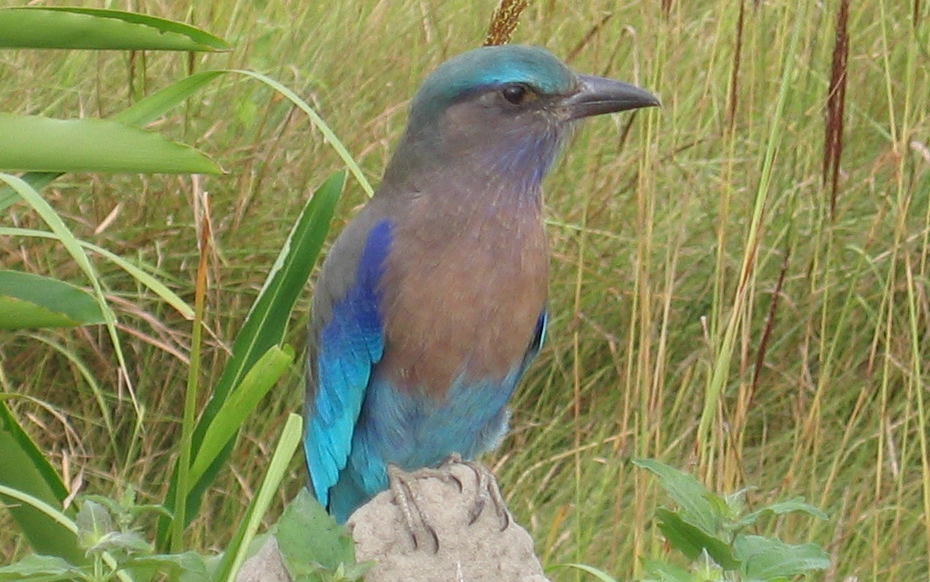Adelicate mist weaves through the clumps of grass. Dew drops glisten like topaz crystals in the pale dawn. Daybreak during a trip to Kaziranga National Park is a breathtaking transition from cold grey to brilliant gold. Swamp deer, graceful silhouettes against the glowing horizon, trot past wild buffaloes wallowing in secluded mud baths. Gilded grass turns to green, and the nip in the air ebbs, warmed by the rising sun. A new day dawns on the grassland. Our elephants amble on in silence, rustling through the freshness. There is hushed anticipation as we proceed deeper into the grassy plain. “We will see them for sure,” whispers our mahout. A noisy family on one of the elephants is shushed by the disapproving guard, much to our relief. The grass around us gets taller, one can now see why this is called ‘elephant’ grass — if it were not for the people on its back, we would barely be able to spot the elephant ahead of us. I resist the temptation to run my fingers along the graceful dewy blades snapping past me; if you catch the edge, it can slice pretty meanly into your finger. We squelch through a marshy patch, tipping precariously as our elephant yanks one foot out, only to sink another one in. We arrive at a steamy waterhole and, apparition- like, two rhinos emerge amidst the tall grass. That is Kaziranga for you.
One-horned apparitions
While we watch from a distance, they fall back to their playful exchange, one nosing the other gently on the head, a rare gesture among adult rhinos. They seem so at peace; the intimate safety of the mist and the silence of the grassland quieten all of us, 25-odd tourists on elephant back. The sun is higher and the grassland colours have now come alive. The next rhino we come across has just risen from a wallow and is grazing on tender grass, his hide washed clean. An egret lands on his back to catch an easy snack. Foraging intently, this rhino seems unperturbed by the ring of elephants and humans around him. This time some mahouts oblige requests for a closer view. And soon the moment is safely stashed in digital memory cards! Later in the day, at the end of our morning jeep safari, we wait to see if a rhino we’ve spotted in the grassland below will cross the road; instead, it decides to clamber onto the road, lower its head and give us quite a chase. It is only in those few terrifyingly exhilarating moments at the back of the fleeing jeep that I actually realise the power and speed these ponderous animals can muster. And Kaziranga National Park is the world’s last major stronghold of these magnificent creatures.

Photo by Anupom Sarmah
The Park
Kaziranga, in the language of the Karbi tribe, means ‘where the mountain goat has water’. It was a swampy, almost inaccessible wetland, used as hunting grounds by local tribes and shikaris up to 1905, when Lord Curzon proposed to declare it a reserve forest. This declaration was finalised and the area officially closed for shooting in 1908. In 1950, it was declared a wildlife sanctuary and, in 1974, Kaziranga was given its current status as a National Park. Flat grasslands with streams and, large, landlocked water bodies (beels) constitute Kaziranga’s terrain. Tall elephant grass covers most of the land, sometimes opening into foraging grounds with shorter grasses, few tall trees and cane thickets. A river and many rhinos Almost every year in the monsoon, Kaziranga is submerged by the backflow of the Brahmaputra in spate — this flood helps rejuvenate the forest, recharges the wetlands with fish stock, clears hyacinth and other debris, and brings in silt to give the grassland new life. However, in some years, when the flood level rises drastically, there is widespread loss of wildlife as animals cannot get to high ground fast enough. Declared a World Heritage Site by UNESCO in 1985, Kaziranga is acknowledged for its importance as one of the last undisturbed habitats of the great Indian one-horned rhinoceros. That adds one more to the many other UNESCO World Heritage Sites in the country. Thanks to conservation efforts, today there are over 1,500 rhinos here. It is also home to over 70 per cent of the world’s wild buffalo population. The rare swamp deer is also found in plenty here. Kaziranga sustains over a 1,000 wild elephants and 450 species of wetland, grassland and woodland birds, of which 18 are globally threatened. The huge number of rhinos and the threat of an epidemic wiping out the population, has led to suggestions that rhinos be moved to other parts of Assam.
Some fast facts to remember
Location
Kaziranga NP in Central Assam is the state’s premier wildlife habitat and stretches east to west along the south bank of the Brahmaputra, which marks its northern boundary. The Karbi Anglong Hills run along its southern boundary. It spreads across two districts, Nagaon and Golaghat.
Distances
88 km W of Jorhat, 215 km NE of Guwahati
Route from Guwahati
NH37 to Kaziranga NP via Dispur, Nagaon, Jakhalabandha and Hatikhuli. To know more, check out ixigo’s page on Guwahati to Kazirang .
When to go
November to late March, early April. Best sightings are in end of March to early April.
Park closes from May to mid- October.
Go there for Rhinos, elephants, hoolock gibbons.
Wildlife/ Forest Dept office DFO Bokakhat, Dist Jorhat; Tel: +91-3776-268007 STD code Kohora 03776.
By Kshitiz





